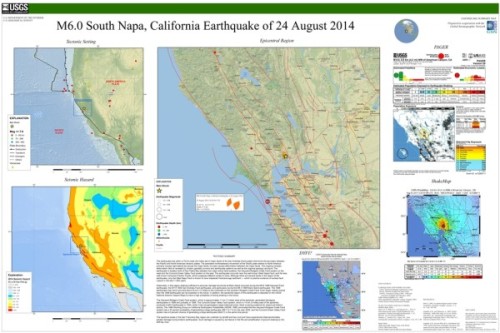
Relevance of National Preparedness Month for Californians
By Katie Francis
This September marks the eleven-year anniversary of the Ready Campaign’s National Preparedness Month. The Campaign, supported by the Federal Emergency Management Agency (FEMA), aims to ensure that Americans are both aware of and prepared for the possibility of natural and man-made disasters.
In addition to making a family emergency plan and building an emergency supply kit, the Ready Campaign urges citizens to be informed about the types of emergencies that can happen in their area and how to respond to them appropriately. For Californians, this usually means earthquake preparedness.
The importance of earthquake preparedness seems especially obvious in light of the recent South Napa Earthquake. The quake that struck the region on the morning of August 24 was of 6.0 magnitude, the largest in the Bay Area since 1989. After-effects included several serious injuries, disruption of water and power services, and hundreds of millions of dollars in property damage.
Dr. David D. Jackson, professor emeritus of geophysics at UCLA and faculty member of the Institute of the Environment and Sustainability, believes that events such as the recent earthquake in Napa are cause to consider whether each of us would be prepared for a similar event in our life.
As a seismologist, Dr. Jackson takes preparation seriously. Some of his tips for preparation include maintaining a good store of fresh drinking water and non-perishable food, keeping cash around in case of non-functioning banks and ATMs, and storing a crowbar in an accessible location so that damaged doors or windows can be plied open. As additional safety measures, the Ready Campaign recommends ensuring that all shelves and breakable hanging objects are securely fastened to a wall, repairing any defective electrical wiring and leaky gas connections to reduce fire risk, and storing all toxic or flammable products on bottom shelves in securely closed cabinets. The Campaign’s earthquake page contains more information on earthquake preparedness and response.
The risk of another serious earthquake occurring in California within the next few years is substantial, says Jackson. The likelihood of a large quake (magnitude 6.0 or higher) taking place in the next five years is about 63 percent — in the next ten years, it’s 86 percent, and in the next 15 years, the likelihood jumps to 95 percent.
Serious earthquakes are most likely to occur along major fault lines and in areas that have recently experienced a quake, but they could occur almost anywhere, and are usually without warning. While early warning systems do exist, they are only capable of giving warnings up to a few tens of seconds in advance. A message can be sent at the speed of light upon a seismograph’s detection of the first waves, whereas the waves themselves travel at the speed of sound — this results in the message arriving only seconds earlier. Earthquake prediction in terms of days or months, however, is not feasible, and likely never will be due to the difficulty of measuring events so far below the earth’s surface.
The reality is that earthquakes can and will occur without warning, and Californians are at risk. However, by taking a few easy steps to be informed and prepared, we can greatly reduce our own personal risk. In Dr. Jackson’s words, “even though we can’t predict earthquakes, it’s not a bad idea to assume that one is predicted for tomorrow, and to make the preparations today.”
